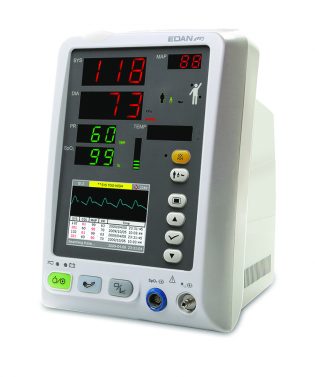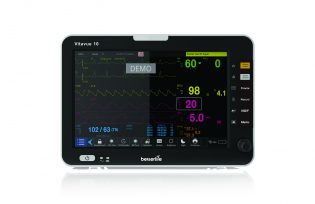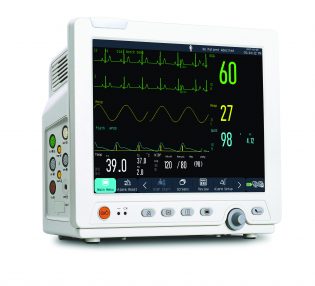Good first response and medical assistance has to start with a careful assessment of vital signs.
These provide healthcare operators and medical staff with the basic indicators that help them to understand the conditions of the patient.
Cardiac activity, blood pressure, breathing, oxygen saturation and body temperature are the indicators on which to base the methods of intervention of medical staff, precisely and promptly.
Multi-parameter monitors allow synchronous and complex measurement of vital signs, either instantaneous or over an extended period of time. They can be used to obtain a quantitative and qualitative display of the patient’s state of health, through the allocation of numerical values and examination of the relative waves.
They are used in hospitals, medical centres and ambulances, as well as in home care in certain cases. These monitors have indicator lights and acoustic alarms to warn medical staff or carers of any anomalies or when the minimum and maximum threshold values are exceeded.
In detail:
What are the main parameters monitored by multi-parameter monitors?
The multi-parameter monitors currently available allow measurement of a really broad range of parameters, with configurations that can be customised to the patient’s specific needs.
The main parameters measured are:
ECG: an electrocardiographic waveform that describes the electrical conduction of the heart. Two selectable ECG waveforms are normally displayed on the monitor. This is continuous monitoring that serves to detect malign arrhythmias, tachycardia or bradycardia rhythm, as well as displaying the QRS complexes.
PR interval: this is the numerical value of the heart rate and indicates the number of beats of the cardiac muscle per minute. It is detected by measuring the QRS complexes and is a variable figure with physiological reference values that depend on age.
BLOOD PRESSURE: a numerical value indicating the cardiac output and the resistance exerted by blood vessels to blood flow. It can be measured using a cuff in a non-invasive procedure or using a catheter in an invasive one.
A monitor allows three different pressure values to be displayed:
- Systolic pressure: this value depends on the force of contraction and elasticity of the blood vessels and is attributed to the maximum blood flood pushed out at each systole.
- Diastolic pressure: this value depends on the duration of diastole and the resistance of the blood vessels and is measured when the heart relaxes between beats.
- Differential pressure: this is the difference in value between the systolic and diastolic pressure and is used to calculate average blood pressure.
BLOOD OXYGEN SATURATION: this measures the quantity of oxygen-saturated haemoglobin against total haemoglobin. It is a percentage with physiological values between 95% and 100%. It is essential to contextualise the clinical history of each individual patient to assess, also based on examination of the pleth waveform, whether a specific medical intervention is necessary.
RESPIRATORY RATE: this is the number of breaths per minute. The physiological reference values are between 16 and 20 rpm and a waveform describing the quality of the breaths is always present on the screen.
BODY TEMPERATURE: this is measurement of the body temperature in degrees centigrade, using internal or external probes.
What are the main types of multi-parameter monitor available?
Multi-parameter monitors differ mainly in where they are used and the complexity of the configurations that are selectable.
The Dimed range by Moretti comprises three types of multi-parameter monitor, with an increasing range of functions and complexity.
O ur vital signs monitor allows rapid measurement of blood pressure (NIBP) and oxygen saturation (SPO2). It has a double digital LED and 3” LCD display and is easy to handle and quick to use, mainly in an A&E department.
ur vital signs monitor allows rapid measurement of blood pressure (NIBP) and oxygen saturation (SPO2). It has a double digital LED and 3” LCD display and is easy to handle and quick to use, mainly in an A&E department.
 Our portable patient monitor, on the other hand, in its standard configuration, allows measurement of ECG, NIBP, SPO2, breathing and temperature. It is light and easy to transport, thanks to its low weight and retractable handle.
Our portable patient monitor, on the other hand, in its standard configuration, allows measurement of ECG, NIBP, SPO2, breathing and temperature. It is light and easy to transport, thanks to its low weight and retractable handle.
 Our most complex multi-parameter monitor is the bedside patient monitor, which is normally used in intensive care and can be configured with both standard parameters and with advanced parameters to offer a greater level of care.
Our most complex multi-parameter monitor is the bedside patient monitor, which is normally used in intensive care and can be configured with both standard parameters and with advanced parameters to offer a greater level of care.
Contact us for more information on Moretti multi-parameter monitors







